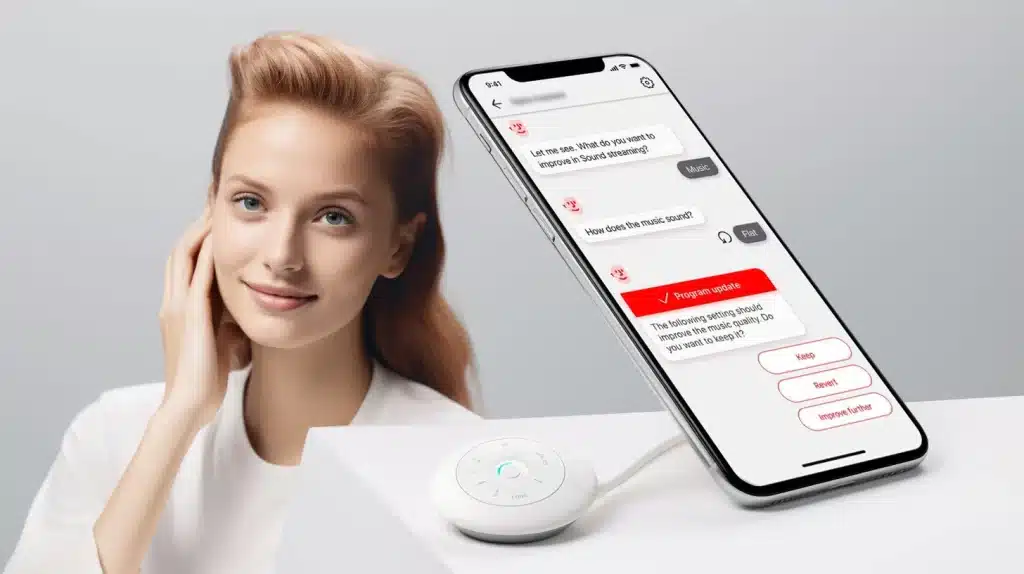ARTIFICIAL INTELLIGENCE IN AUDIOLOGY: HOW AI IS TRANSFORMING THE HEARING AID EXPERIENCE

16 July 2023
In a time when artificial intelligence is making its mark on every business, it’s nice to see that it’s making a difference in healthcare, and more specifically in hearing aids. Hearing aid adjustment has always been a highly individualized procedure involving fine-tuning in a controlled, clinical setting. This strategy, however, has drawbacks since it can not fully simulate the auditory obstacles that users face in real-world scenarios such as noisy restaurants or concerts.
That’s where new hearing aid apps, based on artificial intelligence, come in to change the lives of people affected by hearing loss. These apps bridge the gap between clinical environments and everyday life, enabling precise hearing aid adjustments within the limits of what is recommended and configured by the hearing care professional. This makes hearing aids more personalized and effective than ever. It’s a revolutionary solution that strives to overcome the limitations of traditional adjustment by offering a highly personalized experience that adapts to the user’s lifestyle. This new frontier in hearing aid technology enables hearing care professionals to further examine and optimize the fitting process.
How new AI-enabled hearing aid applications work
The revolution brought about by these applications centers on their ability to integrate artificial intelligence into the hearing aid fitting process in real-world scenarios. Unlike traditional methods, which mainly involve adjustments in quiet clinical environments or with noise simulators, artificial intelligence opens the way for personalized experiences in noisy, dynamic environments – a breakthrough that truly reflects the user’s lifestyle.
The initial appointment for adjusting the hearing aids forms a good starting point for users. However, many of them require further fine-tuning of the settings to optimize their hearing experience. Before the advent of the AI enabled hearing aid applications, users often communicated with their audioprosthetistes only after encountering a problem.
In a transformational shift, the AI enabled hearing aid applications allows users to evaluate fine-tuning and report issues as they occur. This immediate feedback is relayed to the HHS, who can review these changes during the user’s next visit. The system leverages deep learning neural networks to identify usage patterns and make fine-tuning suggestions to the user, utilizing a vast, continually updated data network driven by regular use of AI enabled hearing aid applications.
This approach provides several advantages to both the user and the HHS, enhancing the partnership between them. Instead of following a one-size-fits-all adjustment strategy, the tool facilitates highly customized solutions, considering the unique hearing patterns and daily situations that users face. Thus, the fine-tuning of hearing aids is no longer a periodic clinical exercise but an ongoing, personalized process fueled by real-time data and artificial intelligence.
AI enabled hearing aid applications – an AI chat approach

The essence of the latest generation of applications lies in their simplicity and immediacy. When a user encounters a problem, they can activate their smartphone app. Instantly, the artificial intelligence available in the app chat suggests a solution – for example, changing a hearing aid setting – which is then programmed into the hearing aids. The user can choose to retain or reject the modification, or request further adjustments to improve their hearing experience.
The AI enabled hearing aid applications gathers information from three primary sources to formulate these suggestions:
- The user’s listening situations and the issues reported within these scenarios.
- Anonymized data based on the usage habits of other AI enabled hearing aid applications users.
- The individual preferences of the user.
This intelligent use of combined data ensures that every suggestion provided by the AI enabled hearing aid applications is precisely tailored to the user’s needs and experiences.
All changes made by the AI enabled hearing aid applications are available for the audioprosthetists to review in the application fitting software during the user’s next clinic visit. This creates a cohesive system for audioprosthetists who can utilize the data on user preferences as a premise to deepen consultation during follow-up visits. The system essentially mimics a 24/7 available hearing health specialist, ensuring fine-tuning and personalizing hearing aids with real-time data. As a result, users get immediate solutions to their problems, and the entire adjustment process becomes more intuitive and responsive.
The role of healthcare specialists
The advent of AI enabled hearing aid applications does not diminish the critical role of audioprosthetists; instead, it enhances it. By keeping track of the real-time adjustments made by the AI-powered assistant, audioprosthetists are given an insightful peek into the user’s experiences outside of the clinical setting.
Each adjustment made by the AI enabled hearing aid applications is recorded and made available for audioprosthetists to review through the AI fitting software. This access to real-time data provides audioprosthetists a nuanced understanding of the user’s individual preferences, challenges faced, and the overall usage pattern. These data points become crucial when audioprosthetists meet users during their follow-up visits, offering an evidence-based starting point for discussions and further tuning.
The system essentially creates a seamless continuity of care where the audioprosthetists can utilize data on user preferences to offer more personalized service during their consultations. The result is a comprehensive approach to hearing aid management that pairs real-world, data-driven AI adjustments with the expertise of healthcare professionals. This innovation brings about a high level of personalization and satisfaction, ensuring users have their unique hearing challenges effectively addressed, and audioprothesistes are given tools to provide a more precise service.
Effectively, the introduction of the AI enabled hearing aid applications mimics the feeling of having a dedicated hearing health specialist available round the clock. Thanks to its intuitive nature and quick response time, the AI-powered tool ensures real-time fine-tuning of hearing aids, ensuring a personalized, satisfactory auditory experience. This real-world data, combined with the professional insight of the audioprosthetists, helps optimize the hearing aid experience like never before.
Research findings and user acceptance
A recently conducted study examined data from over 58,000 hearing aid users worldwide who utilized the AI enabled hearing aid applications. This extensive research focused on issues reported by the users and solutions proposed by the AI enabled hearing aid applications. A key metric used in the study was the acceptance rate of the provided solutions, defined as the number of solutions proposed by the AI enabled hearing aid applications that were accepted by the users and retained in their hearing aids.
Intriguingly, the data reveals that the overall acceptance rate for all proposed solutions rose to 80.5% in the last quarter analyzed. This growing acceptance rate sends a clear message: the AI enabled hearing aid applications are successfully delivering widely accepted solutions and have progressively improved performance over time.
The study also revealed acceptance rates in the three main problem categories: sound quality, the user’s own voice, and other voices. Each of these categories demonstrated significant user acceptance and satisfaction, indicating that the AI enabled hearing aid applications were effectively addressing the most common issues users faced in various real-world auditory situations.
The increased acceptance rate and the diverse range of issues addressed illustrate how the AI enabled hearing aid applications are transforming the hearing aid experience. It offers the potential for a future where hearing aids are not merely clinical devices but personalized, intelligent tools that enhance user experience in everyday life.
Breaking the bounds of traditional fine-tuning methods
The introduction of AI enabled hearing aid applications has not only improved the audiological health services but also exceeded the boundaries set by traditional hearing aid adjustment methods. Its unique approach provides several potential benefits to both hearing aid users and audioprosthetists.
Among the benefits of using the AI enabled hearing aid applications are:
- Immediate Solutions: Users get immediate solutions to problems they face in various listening situations, at any time. This responsiveness goes beyond what is feasible with traditional fine-tuning, giving users a higher level of control and flexibility.
- Continuous Improvement: The system utilizes machine learning to formulate solutions based on each user’s unique needs. This allows for continuous improvement over time as the AI learns more about the user’s preferences and usage patterns.
- Transparent System: audioprosthetists gain access to real-time user preferences, enabling them to provide better counseling and more precise adjustments during follow-up visits. This seamless integration of technology and professional expertise enhances the overall service and care for the user.
In essence, AI enabled hearing aid applications is a game-changer in the field of hearing aids. By enabling users to receive more personalized solutions based on their unique auditory challenges, it significantly improves the overall hearing aid experience.
By enhancing traditional fine-tuning methods, AI enabled hearing aid applications has the potential to revolutionize the hearing aid adjustment process. The result is a higher acceptance rate, an increased satisfaction rate among users, and the beginning of a new era in hearing aid technology where users are empowered with control, flexibility, and personalized care. This shift brings us closer to a future where hearing aids aren’t merely devices but intelligent companions, perfectly attuned to their users’ needs.
The future of hearing aid adjustment

The introduction of the AI enabled hearing aid applications marks an exciting turning point in the journey towards more personalized and effective hearing aid adjustment. By employing artificial intelligence, this system offers users immediate, highly individualized solutions, thereby enhancing their hearing experience significantly.
This leap towards AI assistance is not merely an incremental upgrade but a quantum leap in technology that can transform lives. It empowers users to fine-tune their hearing aids in real-world situations, far from the confines of a clinical setting. This real-time adaptability is particularly important given the diverse and unpredictable nature of the environments we encounter daily. Restaurants, concerts, busy streets, or quiet libraries – each situation demands unique auditory responses. With AI enabled hearing aid applications, these adjustments can happen immediately, as and when required.
For hearing health specialists, this AI revolution is an opportunity to take their services to the next level. By gaining access to a wealth of data about user preferences and listening situations, they can provide more personalized and precise care, enhancing their consultations and ensuring a more satisfied clientele.
In conclusion, the AI enabled hearing aid applications is an innovative breakthrough that offers a glimpse into the future of hearing aid technology. By pushing the boundaries of what’s possible, it allows for a more user-centric approach to hearing aid adjustment, resulting in increased user satisfaction and acceptance. As we look to the future, the combination of AI and audiology, like what we see in AI enabled hearing aid applications, has a lot of promise to change the way we hear and connect with sound. Hearing aids won’t just help people hear better in the future; they will also help them live better. And innovations like the AI enabled hearing aid applications, which are based on AI, bring us one step closer to making that happen.
Conclusion: a revolutionary shift in audiology
It is evident that the AI enabled hearing aid applications have begun a revolutionary shift in the audiology industry. This innovative application of artificial intelligence is transforming how hearing aids are adjusted and used, resulting in a more personalized, efficient, and satisfying experience for users.
Moreover, it has redefined the relationship between users and hearing health specialists. Instead of occasional, appointment-based adjustments, we now have an ongoing, data-driven dialogue that enhances the quality of care. It’s a monumental shift from a reactive model of care to a proactive, user-centric approach, promising more than just better hearing, but a significantly improved quality of life.
AI enabled hearing aid applications are more than just a new piece of technology. It’s a new way of thinking about hearing that focuses on each person’s wants, tastes, and real-life situations. It offers personalized solutions like never before because it can learn and change to meet the user’s specific hearing needs.
The latest generations of hearing aid apps push the boundaries of what’s possible by combining artificial intelligence and audiology. It also gives a glimpse of a future where hearing aids will be as unique as the people who use them. This future isn’t just about hearing aids; it’s also about intelligent partners who understand and respond to our needs, changing the way we hear and enabling us to live our lives to the full. With these applications leading the way, that future is closer than ever.
Autres articles
CONSULT AN ENT SPECIALIST IN CASE OF VERTIGO
Often, people suffering from vertigo – that is to say, a strong sensation of dizziness and a loss of balance…
NOISE IN THE WORKPLACE: WHAT TO DO IN CASE OF OCCUPATIONAL DEAFNESS
Updated on July 07 2023 The incidence of occupational deafness in certain vocations cannot be understated. In Quebec, it is…
PROGRESSIVE HEARING LOSS WITH AGE: IS IT INEVITABLE?
As we get older, all our organs age, and the cells of the inner ear are no exception. It’s a…


